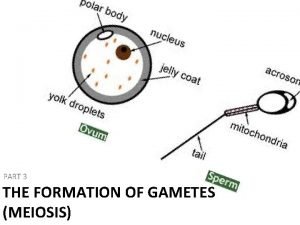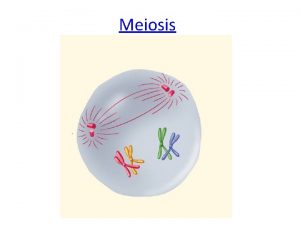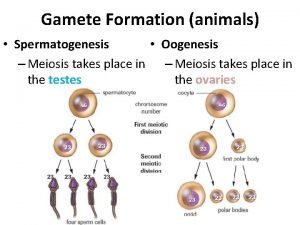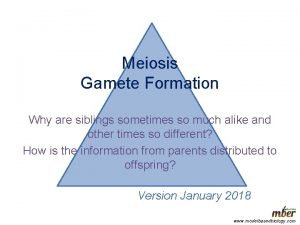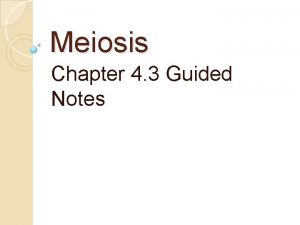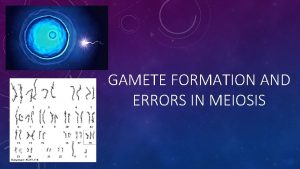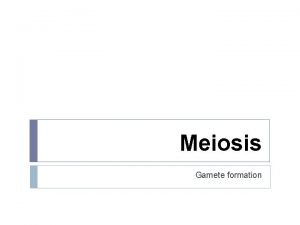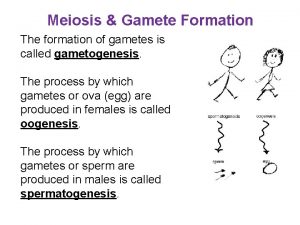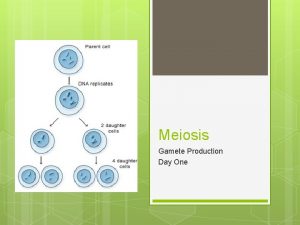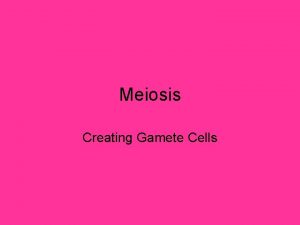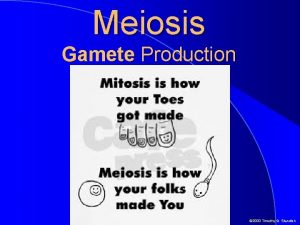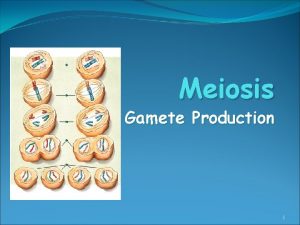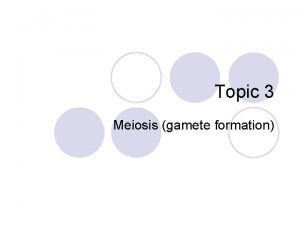Meiosis Gamete Formation Homework 11 4 in Guided













- Slides: 13

Meiosis Gamete Formation

Homework • 11 -4 in Guided Reading Workbook

Reproduction • Asexual reproduction - Asexual reproduction is the formation of new individuals from the cell(s) of a single parent. The new cell (daughter cell) is usually identical to the parent. • Sexual reproduction - In sexual reproduction, two individuals produce offspring that have genetic characteristics from both parents. Sexual reproduction introduces new gene combinations in a population

Apply what we learned about human cells to drosophila melanogaster. • Does 2 N or N represent this cell best? • Is this cell haploid or diploid? • What number does N represent?

Homologous - term used to refer to chromosomes that each have a corresponding chromosome from the opposite-sex parent Homologous chromosomes are similar in shape, position and information, but not identical to each other.

Meiosis • Meiosis is a process of reduction division in which the number of chromosomes per cell is cut in half through the separation of homologous chromosomes in a diploid cell. • Tetrad - structure containing 4 chromatids that forms during meiosis. • crossing-over - process in which homologous chromosomes exchange portions of their chromatids during meiosis

• Formation of a tetrad while going through the process of crossing-over • This occurs during prophase I of meiosis

Meiosis is broken down into two halves. Meiosis I an Meiosis II

Meiosis II

Gamete Formation • Meiosis produces four genetically different haploid cells.

Comparing Mitosis and Meiosis • Similar processes with very different and distinct outcomes • Mitosis results in the production of two genetically identical diploid cells (2 N), whereas meiosis produces four genetically different haploid cells (N).

Diploid - term used to refer to a cell that contains both sets of homologous chromosomes Haploid - term used to refer to a cell that contains only a single set of chromosomes and therefore only a single set of genes

Chromosomes Human’s have 46 chromosomes 23 from your mother’s egg 23 from your father’s sperm A normal human cell is a diploid cell (2 N) A sex cell or gamete (egg or sperm) is a haploid cell (N) In human cell’s what does N represent? 23 chromosomes
 Gamete in meiosis
Gamete in meiosis Prophase 1
Prophase 1 Gamete formation
Gamete formation Chromosomes form tetrads during
Chromosomes form tetrads during How many chromosomes do we have
How many chromosomes do we have Meiosis functions
Meiosis functions Chapter 10 section 10.2 meiosis worksheet answer key
Chapter 10 section 10.2 meiosis worksheet answer key Concept mapping chapter 10 meiosis 1 and meiosis 2
Concept mapping chapter 10 meiosis 1 and meiosis 2 Prophase 2
Prophase 2 Difference between meiosis 1 and meiosis 2
Difference between meiosis 1 and meiosis 2 Disvantages of sexual reproduction
Disvantages of sexual reproduction Section quick check chapter 10 section 1 meiosis answer key
Section quick check chapter 10 section 1 meiosis answer key Meiosis 1 vs meiosis 2
Meiosis 1 vs meiosis 2 Jack prelutsky homework oh homework
Jack prelutsky homework oh homework
